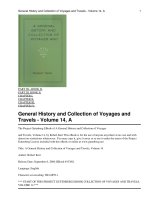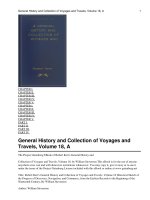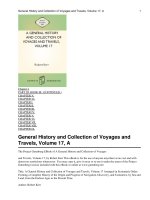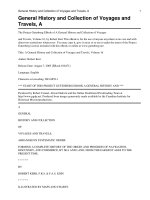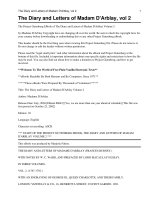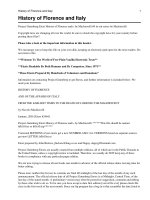The Medieval World (History of Costume and Fashion Volume 2) - Philip Steele (2005)
Bạn đang xem bản rút gọn của tài liệu. Xem và tải ngay bản đầy đủ của tài liệu tại đây (3.42 MB, 64 trang )
A History of
Fashion and
Costume
The Medieval
World
Philip Steele
The Medieval World
Copyright © 2005 Bailey Publishing Associates Ltd
Produced for Facts On File by
Bailey Publishing Associates Ltd
11a Woodlands
Hove BN3 6TJ
Project Manager: Roberta Bailey
Editor: Alex Woolf
Text Designer: Simon Borrough
Artwork: Dave Burroughs, Peter Dennis,
Tony Morris
Picture Research: Glass Onion Pictures
Printed and bound in Hong Kong
All rights reserved. No part of this book may be
reproduced or utilized in any form or by any
means, electronic or mechanical, including
photocopying, recording, or by any information
storage or retrieval systems, without permission in
writing from the publisher. For information
contact:
Facts On File, Inc.
132 West 31st Street
New York NY 10001
Facts On File books are available at special
discounts when purchased in bulk quantities for
businesses, associations, institutions, or sales
promotions. Please call our Special Sales
Department in New York at 212/967-8800 or
800/322-8755.
You can find Facts On File on the World Wide
Web at:
Library of Congress Cataloging-in-
Publication Data
Steele, Philip, 1948–
A history of fashion and costume.
The medieval world/Philip Steele.
p. cm.
Includes bibliographical references and
index.
ISBN 0-8160-5945-4
1. Clothing and dress—History—
Medieval, 500–1500
GT575.S84 2005
391/.009/02—dc 22 2004060891
The publishers would like to thank the
following for permission to use their
pictures:
Art Archive: 7, 8, 9, 10, 11, 14. 15
(both), 16, 19, 21, 22, 25 (bottom), 26,
27, 28, 30, 32, 33, 34, 35, 36, 37, 39, 40,
41, 43, 45, 47, 48 (top), 49, 51, 53 (top),
54 (both), 55, 56, 57, 58, 59
Werner Forman Archive: 12, 13, 25
(top), 38, 48 (bottom), 53 (bottom)
Contents
Introduction 5
Chapter 1: Europe 500–1000 6
Chapter 2: Europe 1000–1400 16
Chapter 3: Europe 1400–1550 26
Chapter 4: Africa and Asia 500-1550 36
Chapter 5: Oceania and the Americas 500-1550 50
Timeline 60
Glossary61
Further Information 62
Index 64
Introduction
The costumes of the Middle Ages still fascinate us. Children’s
fairytale books are filled with fanciful pictures of European
princesses in tall “steeple” hats, of honest woodcutters in
homespun cloth, of knights in shining armor, and colorful
court jesters. Medieval costume inspired romantic poets and
artists of the nineteenth century, as well as the makers of
fantasy films in the twenty-first.The reality of medieval
costume is every bit as interesting as the fantasy.
Finding Out
How do we discover the truth about the way people dressed
in the medieval period? Firstly, actual items of jewelry, crowns,
shoes, suits of armor, and the remains of textiles have survived.
The latter may be fragments of cloth uncovered by
archaeologists, or they may be whole garments now preserved
in a palace or museum. Secondly, there are visual references
supplied by statues, memorial brasses in churches, paintings, or
illustrated manuscripts.Thirdly, we have descriptions of
clothing in medieval literature, or references to it in other
written records such as laws, tax receipts, or trading accounts.
When and Where?
The term “Middle Ages” strictly refers to the period of
European history between the classical and the modern age.
It begins with the fall of the Roman Empire in the west, in
476 CE, and may be said to end with the fall of the eastern
Roman, or Byzantine, Empire in 1453. It is sometimes
extended to include the Renaissance, the cultural reawakening
which began in southern Europe and continued into the mid-
sixteenth century.
This book deals broadly with the period 500 to 1550 CE and
looks beyond the frontiers of Europe to the Silk Road, the
ancient trading route between China and the West. It visits the
dye pits of Kano in West Africa and crosses the Indian and
Pacific Oceans. It describes the dress of the Incas in Peru and
the feather craftworkers of Aztec Mexico.
Costume does not just reveal ideas about beauty or fashion.
It tells us about craft, technology, politics and power, social
classes, religion, customs, childhood, and the world of work.
It is the key to a bygone age.
6
This
Anglo-
Saxon
ceremonial helmet, from
Sutton Hoo in England,
dates from about 625. It
shows Roman influence in
its design.
Raiders and Riders
W
hen the Roman Empire finally
collapsed in 476
CE, Germanic tribes
such as the Angles, Saxons, and Franks
were already invading much of
western Europe.The incomers were
warriors and their dress was
practical, designed for riding and
battle, for farming, or for building
new settlements, rather than for
affairs of state, business, or leisure.
Chapter 1: Europe 500–1000
Troubled
Times
The early
Middle Ages in
Europe have
sometimes been
called the Dark
Ages.There
was almost
constant
warfare,
lawlessness, and a
lack of stable
government.This led to
the disruption of
education, and only limited
historical records have survived.
However, the artistic inspiration and
high craft standards of peoples such as
the Angles, Saxons, Irish, or Vikings,
seen for example in their surviving
jewelry, suggest that this age was far
from barbaric.
Kingdoms and
Empires
In eastern and central Europe, there
were invasions by Slavs from
southern Russia, and Magyars
(Hungarians) from Asia. However, the
city of Constantinople or Byzantium
(modern Istanbul), capital of the
Byzantine Empire, did not fall to
invaders.The empire offered all the
pomp and glitter of an imperial court
and provided a living for all sorts of
people, including officials, lawyers,
teachers, merchants, priests, laborers,
and organizers of horse races.
By the seventh and eighth centuries,
new, small kingdoms were being
founded across western Europe, and
in 800 the Frankish ruler
Charlemagne was crowned ruler of
an empire which stretched from the
Pyrenean Mountains, on the borders
7
of Spain, to central Europe.Western
Europe, now mostly Christian, was
becoming a more settled society.
The Social
Background
To understand how people dressed in
the Middle Ages, we need to know
how society was organized.The
feudal system was developing at this
time—a social order based on oaths
of service. Kings granted large areas
of land to their nobles in return for
their loyalty and military support.
Workers promised to supply labor,
military service, and produce to the
nobles in return for military
protection or a roof over their heads.
Increasingly, the superior status of the
nobles was emphasized by their dress,
quality of cloth, and styles of fashion.
Early Medieval
Textiles
Woolen cloth was processed by hand.
Raw wool was carded (combed out)
and then wound onto a handheld cleft
stick, called a distaff. From here it was
drawn out with the fingers onto a
drop spindle, a suspended rod about
eight inches (20 cm) long, fitted with
a disk called a whorl.The whorl kept
the spindle revolving evenly.The pull
of gravity drew the thread downward
as it was twisted by the spindle.Thread
could then be wound into a skein,
for coloring with natural dyes.
The woody stems of the flax plant
were stripped, dried, and then soaked
in water to extract the fiber inside.
This could be spun and woven to
Europe 500–1000
make linen, which was cooler and
smoother than wool.Another plant,
hemp, could be processed to make a
cheaper, scratchier cloth, sometimes
used by poor people. Cotton was still
a rare import for most of Europe.
A reconstruction at
Jorvik, the Viking
settlement of York, in
England, shows the
vertical warp-weighted
loom in use at the time.
A Viking Loom
The Vikings were Scandinavian sea raiders, who
attacked and settled the coasts of western Europe in
the ninth century. Their looms, or weaving frames,
leaned upright against the walls of their houses. The
upright, or warp, threads were kept taut at the base by
stone or clay weights and were separated by a
horizontal bar called a heddle. The horizontal, or weft,
threads were passed through the gap in the warp and
then beaten upwards with a long batten made of wood,
iron, or whalebone. Weaving was done in the home.
8
State and Church
Crowned Heads
The royal crowns of the early
Middle Ages derived from royal
circlets or diadems worn in
Persia, which were adopted by
the Byzantine emperors and
empresses. These crowns
included pendants, jeweled
pieces hanging down on each
side of the face. Kings of the
Visigoths, a Germanic people who
ruled Spain in the 600s, wore
circlets of thick gold set with
pearls and precious stones. Two
centuries later, Charlemagne’s
crown was made up of gold
plaques set with sapphires and
emeralds and decorated with
enameled figures from the Bible.
Many crowns were topped with
crosses, emphasizing that the
king ruled by the will of God.
The warrior bands of the early
Middle Ages would be led by a
chieftain or warlord, who might own
better weapons or armor than his
followers, but who wore no special
clothes to indicate his rank. However,
when kingdoms and empires were
founded, the descendants of those
chieftains had much grander ideas of
their own importance.The
tombstone of Cadfan, seventh-
century ruler of Gwynedd, a small
kingdom in North Wales, describes
him as “the wisest and most
renowned of all kings.”The high
status now enjoyed by even minor
royalty was reinforced by their
costume.
The Frankish emperor
Charlemagne, who lived
from 747 to 814, is shown
here both as crowned
head of state and as a
man of action.
The Byzantine emperor
Justinian I, who died in
565, wears a crown with
pendants and a purple
robe.
9
Robes and Jewels
Western European kings looked
eastward to the splendor of the
Byzantine Empire. Its powerful
emperor wore a long under-tunic
with a looser, shorter outer tunic.The
cloth was of silk, embroidered with
gold thread.The Byzantine empress
wore a long tunic with a richly
embroidered collar and stole, studded
with gems. As in ancient Rome,
purple was the color reserved for the
imperial family. Other European
rulers also began to wear long robes
for state occasions, and decorated
their clothes with jewels.
Regalia
Medieval rulers wore or carried all
sorts of emblems, called regalia (royal
things), to emphasize their status as
representatives of the state.These
included cloaks, rings, scepters, orbs,
swords, bracelets, gloves and, most
importantly, crowns.The full royal
costume would be worn at
coronations and important state
occasions. Medieval kings were
frequently in the saddle, hunting or
fighting battles, and at such times
their long robes would be replaced
by more practical tunics, cloaks, or
shirts of mail.
Religious Dress
Early Christian monks and priests
wore similar tunics and cloaks to
everyone else. However, religious
costume, like royal dress, soon
developed symbolic meanings. In
Rome and Constantinople, bishops
and popes dressed to show that their
authority came from God.Their dress
became very grand.Wide,T-shaped
tunics called dalmatics were of the
same design as those worn by kings
for their coronations. Bishops in the
Celtic Church wore crowns. Clergy
wore long, white tunics called albs
beneath sleeveless mantles called
chasubles. Long stoles or scarves
would be embroidered with the sign
of the cross.
The appearance of the clergy led to
many heated debates in the early
Middle Ages. Monks in the Catholic
Church of Rome shaved a circular
patch from their hair as a symbol of
the crown of thorns worn by Jesus.
However, monks in the Celtic
Church shaved a band across their
hair from ear to ear, a custom which
probably dated back to the druids,
the Celtic priests of the pre-Christian
age.The Catholic Church ruled that
this tonsure (method of shaving) was
unholy. Between the seventh and
twelfth centuries the Celtic Church
was absorbed into the Roman
tradition.
Deacons of the Church
lead the Byzantine
empress Theodora
(500–548) to worship. She
wears a crown and
imperial robes under a
gem-studded collar.
Europe 500–1000
10
Chieftains, Lords, and Ladies
In the early Middle Ages the upper
classes were chiefly distinguished by
the quality of the cloth they wore, by
embroidered hems and cuffs, and by
fine dyes. Broad bands of color were
popular among nobles of northern
Europe.
Tunics and Trousers
The linen or woolen tunic was the
basis of dress across most of Europe
for all social classes and both sexes.
The long tunics and robes of the
Roman Empire were still seen at the
royal court or in church, but shorter,
knee-length tunics were now worn
by noblemen, often with breeches.
These might be bound around the
calves with crisscrossed thongs or
worn with knee-length laced boots
or shoes of soft leather.
Most noblewomen also wore tunics,
with designs that varied with time
and place. In seventh-century Spain
Byzantine Silks
Silk was the most luxurious cloth of all. The
breeding of silkworms and the spinning and weaving
of this shimmering textile had originally been a
secret of the Chinese, but had gradually spread
southward and westward across Asia. The Greeks
and Romans knew about silk, but the first serious
attempt at creating a European silk industry began
at Constantinople in the reign of Justinian I
(c. 482–565
CE). Manufacture took place under high
security, within the palace walls, and was of a very
high standard. The best quality cloth was reserved
for the emperor, but the courtiers also wore fine
silk. Manufacture and trade were strictly controlled
by the imperial court.
the tunic might be more like a dress,
shaped and close-fitting with long
sleeves. In eighth-century France a
looser, calf-length tunic, with three-
quarter-length sleeves, might be
worn over a long shift. Long stoles or
scarves could be draped gracefully
over the shoulders or head.
Noblewomen wore delicate shoes of
soft leather or embroidered linen.
Girdles and Cloaks
Tunics for both sexes were generally
gathered with a girdle or belt, which
might be a strip of fancy leather or
embroidered cloth. Men might wear
an ornate buckle or a sheath for a
knife on their belt, while a woman’s
girdle often supported a satchel, as
there were no pockets in their
garments. Sometimes women wore a
broad sash around the hips, knotted
and hanging down at the front.
Byzantine
noble, 600
Europe 500–1000
11
Even the finest palaces of the early
Middle Ages were drafty places, and
the wooden halls of a prince or
chieftain in northern Europe must
have been bitterly cold in winter.
Warm cloaks of wool, fur, or hide
were a necessity.
Jewelry
Cloaks for men and women were
generally fastened at the shoulder or
the chest by a round brooch secured
with a long pin.The brooch was
often the most elaborate and
beautiful item worn. One of the most
splendid examples is the “Tara”
brooch, made in Ireland in the early
eighth century. It is crafted from
silver, bronze, glass, and amber, and
even the back of the brooch—which
would not have been seen when
worn—is as lavishly decorated as
the front.
Brooches, buckles, pins, necklaces,
and earrings of this period show a
high degree of craftsmanship.
The Viking chieftains of the ninth
century had some very fine examples
made for themselves, and they also
traded or plundered jewelry on their
sea voyages. Hoards of Viking
treasure, buried for safekeeping, reveal
high-quality gold jewelry from all
over Europe and the Middle East.
Enamelled brooch used to
fasten cloaks. It was found
in the bed of the River
Shannon, in Ireland.
French
lady, 850
Anglo-Saxon
noble, 950
12
Working Clothes
In the Roman Empire, most laborers
and slaves wore knee-length tunics,
the most practical dress for plowing,
fishing, or building a house. For
greater mobility, the hem of the tunic
could be drawn through the legs and
tucked up into the belt, similar to a
baby’s diaper.This continued to be
normal working dress during the
early medieval period in southern
Europe.
Cloths and Dyes
Tunics for slaves, or the poorest in
society, were made of the coarsest
woolen, linen, or hemp cloth.These
were undyed. However, middle-class
people, such as merchants, wore
homespun cloth of a better quality.
This might be dyed with the extracts
of flowers, leaves, roots, or bark.
Natural dyes included a plant called
woad, which gave a blue color; a
wildflower called weld, or dyer’s
A simple tunic remained the working dress of
the plowman during most of the Middle Ages.
rocket, which produced yellow; and
madder, an evergreen shrub of the
Mediterranean region, whose root
produced a crimson dye.
Heavy-duty Clothing
The waterlogged clay of northern
Europe required heavier plows than
the lighter soils of the south.
Northern farming was generally
muddier, wetter, and colder, so people
dressed accordingly. As well as the
tunic, short breeches or longer
trousers were generally worn, the
latter often tied with thongs. Shoes of
calfskin or goatskin were tightened
with leather laces. Soles would be
replaced when worn out, and
sometimes shoes were fitted with
wooden soles, like clogs. Knee-length
boots and gaiters tied to linen
trousers were also worn, although
bare legs and feet were common
among the poorest citizens.
Women at Work
A woman’s work in a ninth-century
Viking settlement was fairly typical
of this age. It might include cooking,
fetching water, and looking after
livestock.When summer came and
the men sailed off to raid foreign
shores, the women stayed behind to
run the household and often the
farm as well. A lot of time was spent
spinning, weaving, and making
clothes for the family. A Viking
woman would wear a long shift of
wool or linen, with a sleeveless
woolen tunic over the top.This was
secured with shoulder straps fastened
by brooches. Keys, pins, or other
useful items were often kept on
forward in the front.There were also
broad-brimmed straw sunhats.
Europe 500–1000
13
chains which hung from these
brooches.
Everyday Accessories
Clothes were not made with pockets.
Instead, pouches or purses of cloth or
leather were attached to belts in
order to hold money, hair combs, or
other small or precious items. Not all
jewelry was made of costly silver or
gold. In northern Europe, antler
horn, walrus tusk, bone, wood, glass
beads, and stones such as jet, readily
found on some beaches, were made
into very beautiful ornaments.
Hats were a rare sight in the early
Middle Ages. Simple cloth caps in the
“Phrygian” style of the ancient
Greeks were sometimes worn.These
were conical, with the peak flopping
All Wrapped Up
Most people who wished to
protect themselves from rain or
snow would simply raise their
cloaks to cover their heads. The
cloak could also be wrapped
around the body to serve as
bedding for a weary traveler or a
Viking seafarer. Woolen cloaks
soon became soaked through
with rain or spray, but cloaks of
hide could offer some
waterproofing. Iceland, colonized
by Vikings in 874, became
famous for exporting shaggy
woolen cloaks. In eastern
Europe, Bulgarian sheepskin
coats became popular, worn with
the fleecy side against the body.
Viking women’s dress was
home-made, simple,
practical and often
colorful. Hair was worn
long or tied back. Married
women wore headscarves.
Viking shoes were
generally made of goat- or
calf-skin and were either
slippers or laced around
the ankle.
Dressing for War
After the collapse of the Roman
Empire in the west, large standing
armies rarely took to the battlefield.
Much of the military action was now
carried out by small, mobile bands of
mounted warriors. Most were
ordinary working people who owed
allegiance to a local chieftain or lord.
They wore simple jerkins or tunics
with breeches.A leather belt carried
a scabbard for the sword. Little armor
was worn. Some stitched metal plates
onto their clothes for protection, but
only the leaders owned helmets or
mail shirts.The early Franks piled up
their hair in braids to provide padded
protection for their heads.
It was much the same with the
Viking raiders of the ninth century.
Their simple, conical helmets were
made of iron or hardened
leather. Some had nasals (bars
to protect the nose). A few
leading warriors had
helmets with cheek guards
or ornate protection for
the face.The elite Viking
shock troops were known as
berserkers, or “wearers of
bearskin shirts.”They would
work themselves up into a
blood-crazed frenzy before
battle.We still talk of people in
a rage “going berserk.”
Armies of
Empire
The more orderly, large-scale
military activities familiar to
the ancient Romans lived on
in the Byzantine Empire,
which succeeded in recapturing
former Roman territory in Italy
and North Africa. However, the
old Roman-style legions—large
units of well-trained professional
soldiers—had been disbanded.
The Byzantine Empire was really
a land of merchants, and its rulers
preferred to hire mercenaries to
This decorative helmet,
with an iron cap, would
have been a highly prized
possession. It was found
in a burial at Vendel in
Sweden, and probably
dates from the second
half of the seventh
century.
Europe 500–1000
15
fight for them rather than raise their
own armies.The Byzantine foot
soldiers wore scale armor—tunics of
sewn metal plates—over breeches.
By the reign of Basil II (976–1025),
the emperor was protected by an
elite bodyguard of Rus (Swedish
Vikings who had settled in Russia).
They were known as the Varangian
Guard and wore elaborate armor.
In the early ninth century, the
armies of the Frankish emperor
Charlemagne marched into battle
wearing tunics with cloaks or kilts,
similar to the style of the old
Roman legions.Their helmets were
either rounded or conical with a
ridge along the crest.
Rise of the Knight
In the eighth century, a new
invention called the stirrup reached
Europe, which had originated three
centuries earlier in China. By
securing a horse rider’s foot, the
stirrup allowed him to stay in the
saddle during the shattering impact
of a cavalry charge. By the tenth
century, heavy cavalry was
becoming increasingly important in
Shirts of Mail
Mail was a form of armor invented by the Celts sometime
before the fifth century BCE. The Roman legions, who
adopted the use of mail, called it macula (mesh), and this
became the F
rench word maille. Mail was made up of small,
inter
linking iron rings, riveted or pressed together and shaped
into shirts, and later other forms of garment. In the early Middle
Ages only a few warriors could afford shirts of mail, but from the
ninth century onward it became increasingly common.
warfare.The age of the
knight was about to begin,
and with it would come
many social changes.
These altered the way
people dressed, and not
just on the battlefield.
Angevin knight,
c.1125
Carolingian soldier,
c.800
16
Land and Power
In the eleventh century, as the power
of the Byzantine Empire began to
wane, the Holy Roman Empire—a
loose federation of Germanic states
which had replaced the eastern part of
Charlemagne’s old empire—prevailed
in Europe.The Holy Roman Empire
extended from Bohemia and Austria
to the Netherlands.
Warfare still dominated all aspects of
life.The mounted warriors, the
knights, formed a new social elite.
Tournaments, which were mock battles
between knights, became a colorful
showcase for the latest fashions. Long
wars were fought to enlarge existing
kingdoms or to conquer neighboring
states. Other wars were fought
between kings and rebel barons, who
wanted regional power.
Chapter 2: Europe 1000–1400
T
he feudal system in Europe reached its
high point from the eleventh to the
thirteenth centuries. Increasingly, the
manners, costumes, and even language
of the nobility differed from those of
the common people who served,
labored, and fought for them. By the
1300s, feudalism had begun to
decline. Bankers and merchants—
especially those engaged in the cloth
trade—often became wealthier and
sometimes more powerful than their
feudal lords.
The Age of Knights
Textiles and
Technology
At the height of the Middle Ages,
textiles became a mainstay of the
European economy. In England, more
and more land was given over to
sheep pasture for wool production.
Flanders (modern Belgium) saw rapid
growth in the woolen and linen
trade, bringing huge wealth to its
merchants. High-quality linen was
also produced in France, and silk in
Italy. Cotton appeared in Moorish
Spain, and by the fourteenth century
it was also being woven in northern
Europe.
All commercial aspects of the textile
industry were managed by trading
organizations called guilds.These
representatives of the craftspeople and
merchants controlled prices,
A German manuscript of
1305
–40 shows a grand
tournament. Even the
fashions of the noble
women spectators are
outshone by the gaudy
coats-of-arms and crests
displayed by the knights.
Europe 1000–1400
marketing, and the training of
apprentices.The Guild of Weavers in
London was founded in the early
1100s. At this time, spinning was
considered to be woman’s work and
weaving was left to the men.
By the eleventh century, looms were
mostly horizontal frames rather than
upright posts. In the 1100s, treadles
were added.These were foot-
operated levers, a Chinese invention
which moved the heddle
mechanically and raised alternate
warp threads in sequence.The yarn
was passed through the gap, or shed,
by a hand-operated shuttle, which
contained a bobbin or reel of thread.
Spinning wheels, originally an Indian
or Chinese invention, first appeared
in Europe in about 1200 and were in
common use from the 1300s.They
had a fixed distaff and wheel-driven
spindle.
Eastern Luxury
The high Middle Ages were marked
by conflict between Christianity and
Islam. Beginning in 1095, religious
orders of knights were formed to
fight against Muslims in a long and
brutal series of wars called the
Crusades.These clashes did have
some unexpected outcomes, with
Muslim and Christian cultures
frequently influencing each other.
This happened in the Middle East,
where Christian knights founded the
Crusader states of Outremer in the
eleventh century. In the Kingdom of
Jerusalem, young knights from
northern Europe first came across the
luxuries of Asia. Many of them
adopted Asian dress, wearing long
tunics and robes, pointed slippers,
cloth-of-gold and silk, and turbans on
their heads.This exotic dress
influenced tastes back home in
Europe, as did imports from Moorish
kingdoms in Spain and North Africa,
and from the Byzantine Empire.
17
A French illustration of the high Middle Ages
shows women carding wool, spinning and
weaving.
By 1400 the knight's mail was covered in
sections of plate armor. Here it is being
adjusted by the knight's squire, who is
training to be a knight himself.
18
Ermine and Miters
The kings of the high Middle Ages
continued to wear long tunics and
robes in the Byzantine tradition.The
style of royal dress varied within this
period. For example, royal robes
became extremely long in the early
1100s, and had to be gathered up at
the waist. Long cuffs covered the
hands. Queens wore state robes of
the richest cloths and finest furs.The
fashionable headdresses of the day
were combined with circlets or full
crowns.
The Royal Mantle
A large cloak or mantle, trimmed
with fur, was an emblem of royalty
and noble status. One of the most
highly rated furs was ermine, made
from the fur of the stoat.The coat of
this little animal turns white in
winter, except for the black tip of its
tail.The white fur with spots of black
was much admired, and from the
reign of King Edward III
(1327–1377) onward, only the royal
family was allowed to wear it in
England. Scarlet cloth trimmed in
ermine was later adopted by
European dukes as part of their
ceremonial dress.
Princes of the Church
The Roman Catholic Church—
which split from the Orthodox
Church of the Byzantine Empire in
1054—was at the height of its power
during this period.To most western
Europeans, the popes in Rome were
God’s representatives on earth.They
dressed in splendid robes and jewels,
and wore a kind of crown as a
symbol of their power.This papal
tiara had evolved from the central
part of the ancient Persian diadem
and was worn by all popes from the
ninth century. By the time of Pope
Benedict XII (died 1342), the tiara
was ringed by three crowns, arranged
in tiers.
For religious ceremonies, the pope
and all bishops wore a miter.This
developed from a small crown with
points at the side, worn in Asia. By
the end of the twelfth century, the
During the Middle Ages,
religious dress for men
and women became a
series of uniforms, which
were rich in symbolic
meaning.
19
miter had become a large, cloth-
covered cylinder, embroidered and
beribboned, which split into points at
the front and back.
Monks and Nuns
Some objected to the earthly riches
of the Church and preferred to live
their lives in spiritual retreat. From
the tenth century onward, these
monks and nuns formed different
“orders,” communities devoted to a
religious life.The orders favored very
simple dress and each had its own
uniform.The Dominicans wore
white gowns and black caps.The
Franciscans, who took a vow of
poverty, wore a brown habit with a
cowl, or hood, and a girdle of rope,
whose knots reminded them of their
vows as monks.The Carmelites wore
white and brown stripes, and the
Carthusians wore white only. Nuns
had simple habits with a cloth worn
over the head. By day they wore a
cloth covering for their head and
neck called a wimple.
On Pilgrimage
Great cathedrals were built
across Europe at the height of
the Middle Ages. These and
other holy shrines were visited by
pilgrims in order to pray or ask
for a blessing from a saint.
Popular destinations included
Rome, Jerusalem, Canterbury
Cathedral in England, and the
Cathedral of St. James at
Compostela in northwest Spain.
A typical pilgrim carried a staff
and a satchel and wore a tunic, a
travel-stained cloak, and a broad-
brimmed hat for protection
against sun and rain. Each shrine
had its own small badge made of
lead, which pilgrims could wear
on their hats or cloaks to show
where they had been. The badge
for Compostela was a shell, the
emblem of St. James.
This statue of St James is
dressed as a Compostela
pilgrim. Note the shell emblem.
Europe 1000–1400
20
Fashions changed repeatedly between
the twelfth and fifteenth centuries, as
wealthy young nobles experimented
with outrageous costumes and
hairstyles.Young nobles shocked their
elders and were often criticized by
the Church.
At the beginning of this period,
men’s robes were becoming longer
and shoes were elongated, with
pointed or curled toes. Hair, cropped
at the back of the neck in early
Norman times, was now worn far
beyond the length of a woman’s, and
long beards came into fashion too.
Courtly Fashion
Later, men’s hair was worn much
shorter, with a central part and no
beard.
From the 1340s onward, noblemen’s
garments went to the other extreme,
becoming shorter and shorter, with
the exposed legs covered in fitted
hose. One leg of the hose might be
red, the other blue. Sleeves almost
touched the ground.
From the 1360s, a wide gown with
flared sleeves and a high collar also
became popular. Known as a
houppelande, it was gathered into
The fashions of royalty and
nobility were by now a
world apart from the
everyday dress of
common people.
Europe 1000–1400
21
looked at men. All sorts of hidden
meanings could be read into such
details as the color of a dress being
worn.A lady might give a sleeve or a
scarf to a knight who offered to be
her “champion” at a tournament.
pleats with a belt at the waist. Gloves
were often worn by nobles. Hats
were also now worn, from round
caps trimmed with fur, to separate or
collared hoods with a long point at
the back, which could be wrapped
around or tucked in.
Sleeves and Veils
Noblewomen’s dress remained long
throughout the Middle Ages, with a
variety of tunics and fitted over-
gowns, known as bliauds coming in
and out of fashion.
Some were lined
with furs, and wool and silk of the
finest quality became increasingly
available.The luxury of the cloth
might be shown off in a long train
sweeping the ground behind the
body, or in rich undergarments
revealed through slashes and laces in
the gown. Sleeves might be so tight
that they had to be detached and
resewn after each wearing.
Women’s hair might be rolled or
braided and coiled around the ears.
Hair was generally covered with a
linen veil, and in the twelfth century
the neck and chin were also covered
by a cloth called a barbet.The two
cloths were later joined to form a
single head covering, the wimple. A
net of silk or beads, often supporting
a stiff linen veil held with pins, was
popular in the late fourteenth
century.
The Age of Romance
This was the age of “courtly love,” a
code of behavior that idealized the
love of a knight for a usually married
noblewoman. Courtly love dictated
how ladies dressed and walked and
Sumptuary Laws
Decrees which regulate the spending of the consumer
are called sumptuary laws. They were introduced in
most European countries during the later Middle Ages
in order to limit the purchase of luxury goods. The aim
was sometimes to curb excess, but more often it was to
prevent wealthy merchants’ wives, or others, from
dressing in clothes reserved for the nobility. A French
decree of 1294 does both, banning ordinary people
from wearing certain furs and jewels, and limiting the
amount of clothes a lord or lady might buy in a year.
However, the rising middle classes were so determined
to show off their newfound wealth that such laws rarely
had any lasting effect.
The fashion for ladies to
wear very high
headdresses and hats
began at the end of the
fourteenth century and
reached its most extreme
forms in the fifteenth.
22
Villeins, Merchants, and
Mummers
Peasant Dress
From the eleventh to the thirteenth
centuries, there were few changes in
the dress of the lower classes. Some
were reasonably provided for, but
most were desperately poor.
Common laborers, or villeins, wore
a knee-length tunic or blouse of
homespun cloth with breeches and
coarse hose. On their feet they wore
shoes of cloth, felt, or leather, or
gaiters or wooden clogs. Men of
all classes wore a capuchon, a long
hood which dangled at the back
but fitted closely around the head,
extending over the shoulders as a
collar or cape. A round, linen cap,
which could be tied under the
chin and worn under another hat,
was also popular. Poor women
wore a long gown of homespun
cloth and hose.
An English poem called Piers
Plowman, dating from the late
fourteenth century, describes a poor
peasant family: the man wears rough
clothes full of holes; his wife has
bare, bleeding feet; and the baby is
wrapped in rags. In fact, by that time,
life was beginning to improve a little
for some of the poorest people.The
decline of the feudal system was
leading to a freer life in western
Europe and the payment of regular
wages.The Black Death, a terrible
plague that devastated Asia and
Europe between 1347 and 1351,
reduced the workforce to such a
degree that the survivors had more
bargaining power. Better-quality
woolen and linen cloth, cloaks, hose,
boots, or shoes were now more
commonly worn.
Professions in Gowns
The merchants and middle classes
tended to live within their means,
and generally dressed more sensibly
than their superiors. Doctors had to
wear long gowns, while surgeons,
who were seen as workmen with
lower status, wore short costumes.
Lawyers and university professors
also wore gowns, and their students
were expected to dress soberly too,
even if they did sometimes brawl and
drink too much wine.
A fourteenth-century
English manuscript, the
Luttrell Psalter, shows
farmers wearing belted
tunics, hoods and
brimmed hats.
Europe 1000–1400
23
elaborately costumed as angels, devils,
saints, and martyrs.
May Day and
Mummery
There were many religious festivals
during the Middle Ages, including
some pre-Christian celebrations. On
May Day, both nobles and peasants
would wear green or adorn
themselves with leaves and flowers,
and dance to the music of bagpipes,
drums, or fiddles. Carnival, the period
before the fast of Lent, took on many
of the customs of an old Roman
winter festival called Saturnalia,
during which servants and masters
swapped roles. Revelers, known as
mummers, banged drums and wore
masks and grotesque costumes.They
mocked the upper classes, dressing a
goat as a bishop to preside over the
“misrule.”
Jugglers, Jesters, and
Actors
One group of people who chose to
wear brilliant colors were traveling
acrobats, jugglers, and musicians.
From the twelfth century onward,
when fairs began to sell a wider
variety of fabrics, entertainers began
to wear multicolored outfits in bright
red, yellow, and blue.They were
blamed for spreading a taste for such
outfits at court. Such garish costumes
(known as “motley”) became the
uniform of the jester, a joker who
was paid to fool around and make
fun of people in the great hall of the
castle. Jingling bells were attached to
his cap.
There were no theaters at this time,
but religious shows called miracle
plays were often performed outdoors.
The actors—all men or boys—were
A doctor demonstrates
how to take the pulse. He
wears a cap and a long
gown, as a mark of his
profession.
Mummers shown in a
fourteenth-century Flemish
manuscript.
24
surcoat identified the knight.
Crusaders joined religious orders, like
those of the monks. One of these, the
Knights Templar, wore a white
surcoat with a black cross.The
Hospitallers wore a red surcoat with
a white cross.
Across Europe, surcoats began to
carry the emblem, or charge, of the
wearer’s family.The garment became
known as a coat of arms.A code of
rules was developed to regulate the
colors, patterns, and emblems used.
These rules were known as heraldry,
for it was the task of a royal official
called a herald to identify knights by
their charges. Colorful and elaborate
heraldic patterns also appeared on
shields, standards, and the clothes of
retainers and servants.
Plate Armor and
Great Helms
By the thirteenth century, the
knight’s legs, hands, and feet were
also covered in mail. Mail was
effective, but it could still be pierced
by arrowheads or smashed by maces
and axes, so knights began to strap on
plates of hardened leather or steel for
further protection. By the 1400s,
beautifully made and jointed plate
armor of steel, weighing about forty-
five to fifty-five pounds (20–25 kg),
often covered the whole of the
knight’s body.
The helmet changed too. By the
1200s it was a flat-topped cylinder
with the nasal extended to protect
cheeks and eyes. By 1250 it was the
great helm, a large, bucket-shaped
Hauberks and Coifs
In the 1060s the Normans, who were
based in northern France, invaded the
British Isles and southern Europe.
The Norman knight wore a hauberk,
a knee-length coat of mail weighing
about 30 pounds (14 kg), over a
padded tunic. His head was protected
by a mail hood, or coif, and a conical
helmet with a nasal. Metal points
called spurs, for urging on his horse,
were strapped to his heels.
Coats of Arms
During the Crusades, Christian
knights in the Middle East adopted
the Muslim Saracens’ habit of
wearing a surcoat.This light over-
garment helped protect the armor
from heat and dust. Emblems on the
Knights and Foot Soldiers
A thirteenth-century
manuscript shows
knights clad in mail and
surcoats. Four knights in
the background wear the
great helm.
Europe 1000–1400
25
The Tournament
The mock battle, or tournament, began as a way of training knights. It included free-for-all
fighting (the mêlée) and one-to-one horseback contests, in which one rider had to unseat the
other with his lance. Tournament armor was heavier than field armor, and more padding was
worn underneath. Even so, this was a dangerous sport. Knights began to wear more fanciful
armor at tournaments, their helms decorated with crests, plumes, scarves, and ribbons. It was
the knights’ chance to achieve fame and fortune, and perhaps even a good match in marriage.
The ladies of the court watched from pavilions and galleries, dressed in all of their finery.
helmet, padded inside and covering
the whole coif. Slits and holes in the
helm allowed for vision and
breathing.As plate armor developed,
so did a close-fitting, all-enclosing
helmet called the basinet. From about
1300 this was fitted with a movable
visor, which could be raised for
improved vision.
Fighting on Foot
Foot soldiers and archers still wore
simple tunics and hose, but many
gained protection from padded jerkins
or from mail shirts, armor, and helmets
plundered from the battlefield.
An illustration of about 1340 shows an
English knight, Sir Geoffrey Luttrell, being
handed his jousting helmet, lance and shield
before a tournament. His family coat of arms
appears on his surcoat and his horse’s
trappings.
In the 1300s there were major
uprisings by peasants in western
Europe.They were armed only with
farm implements, knives, and
homemade weapons, and had little
armor.Their rebellions were easily and
harshly suppressed by the knights.
Norman battledress 1070
conical helmet
nasal
coif
mail hauberk
belt
quilted under-tunic
slit skirt to enable riding
kite-shaped shield
prick spur
